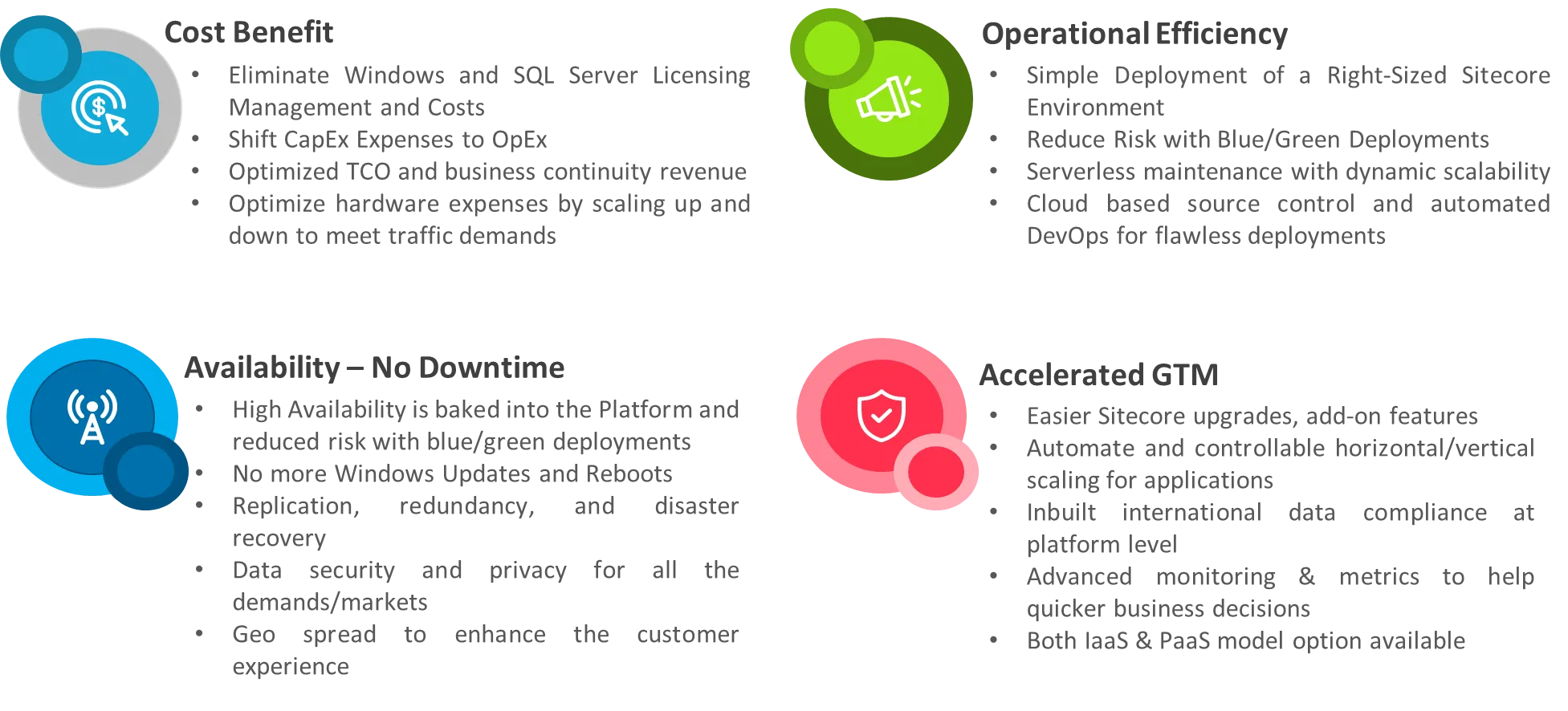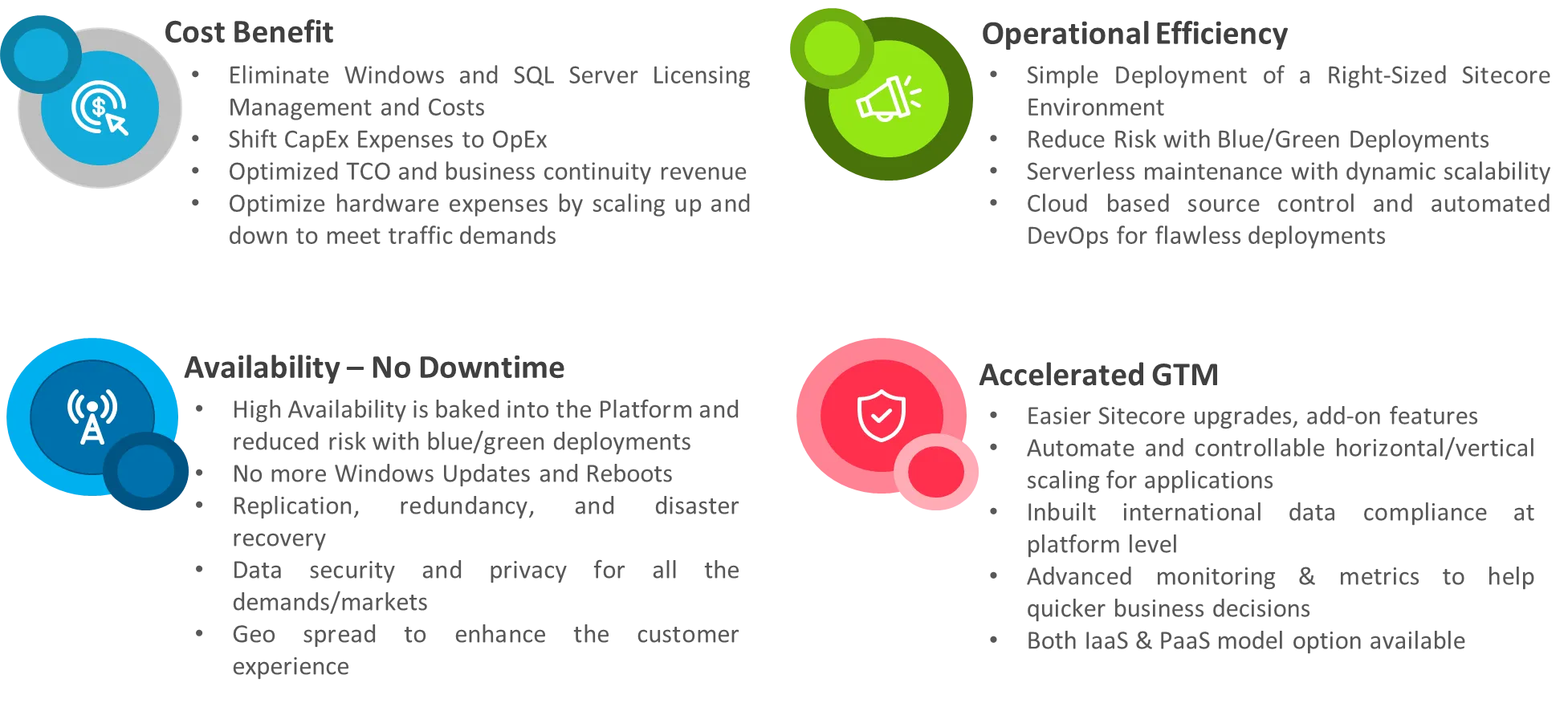Thinking of a future ready, agile Sitecore implementation at scale? Cloud is the way to go!
Blog: Capgemini CTO Blog
We are witnessing a heavy demand from customers moving their workloads to the cloud but when it comes to a customer-experience platform such as Sitecore, enterprises still rely on their local data centers and IT teams to manage the platforms when cloud could easily solve most of their existing platform problems.
The important and business impacting scenarios that enterprises go through when they rely on hosting their Sitecore experience platforms on local datacenters include:
- Availability and security – Frequent downtime and fault tolerance capacity of the platform, which impacts the customer experience at crucial times
- Elasticity/scalability – Huge effort required to meet the customer and business demands while implementing platform capabilities either by adding new functionality/feature to enhance the customer experience or by scaling it to meet business growth
- Cost – Large capital and operational expenditure on the platforms hosted locally and a huge dependency on IT teams to manage the local infrastructure
- Globalization – Meeting the global demand of an enterprise is a challenge due to a major dependency on the local data centers.
To overcome these challenges, we recommend enterprises move their Experience Sitecore Platform Cloud on to platforms such as Microsoft Azure. The benefits that businesses achieve by moving to the cloud span various metrics, including cost, operational efficiency, fault tolerance, and accelerated go to market.

To have a successful cloud platform for Sitecore, there are four important steps we need to go through and ensure that each step has got the due buy-in from business and IT in an enterprise:

Fitment check: First, perform a quick assessment of the existing platform landscape of an enterprise and the related dependencies. Look for the possible dependencies with the line of business applications in case the customer already has a Sitecore installation. Perform a monthly expenditure cost analysis or TCO calculation and choose the right hosting model from Infrastructure-as-a-Service (IaaS) or Platform-as-a-Service (PaaS), whereas Sitecore is available on the PaaS model in Azure.
Pilot step: After finalizing the fitment, hosting model, and topology, we recommend setting up the cloud platform and migrating in a pilot mode. Instead of setting up the full-sized Azure resources, go with the minimum viable product that can hold one or two important Sitecore instances in Azure. Learn by experience while moving the workloads such as databases, integrating APIs, codebases, deployable packages, third-party components, and others before doing a big-bang migration. Through this pilot mode, enterprises can learn how to work in the cloud and define monitoring techniques, and the metrics required to capture, which is not the same as in local infra.
Actual migration: After the business and IT teams are comfortable with the pilot mode, enterprises can transition towards the end-to-end cloud approach for Sitecore. Design and configure the right topology that meets the requirements of the business in a scaled manner
and always consider future demands when designing the cloud resources. Move all the workloads from on premises to cloud, then retire the legacy ones. But keep in mind that until we achieve the complete cloud model, enterprises and associated applications need to continue to work on the hybrid model.
Monitor stabilize and enhance: Look out for monitoring techniques and business-critical metrics that need to be captured in Azure for better understanding and further optimization of resources in the cloud. Stabilize the platform by defining a regular operational and maintenance activity on a daily, weekly, monthly, and quarterly basis through automation. Also, focus on the DevOps process and tools associated with the deployment process and enable quicker feature enablement for business needs. Have frequent checks on the minor and major version releases of the Sitecore and update the platform as and when required.
A couple of important aspects that to be considered while designing the Sitecore topology and Azure resources that ensure an overall project success:
| Area of focus | Platform considerations |
| Sitecore instance sizing |
On-premises scaled setup and Cloud (PaaS) setup varies considerably, choosing the right topology and scaling the required components is important during the pilot |
| Versions (minor and major) | Upgrade to the latest Sitecore version in on premises before actual cloud migration. This drastically reduces the complexity and effort. Azure supports the Sitecore PaaS starting from 9.x only |
| Analytics database | Validate the importance of retaining analytics data and migrate to the cloud as-is from the business standpoint and due to technical dependencies such as history, personalization, and others. The right decision saves considerable effort in the overall migration process |
| Forms and customizations, code versions | Make sure the WFFM (web forms for marketers ) are converted to Sitecore forms and the related customizations are upgraded with the latest versions |
| API management | Validate the possibility of leveraging Azure API management and migrate the APIs from on premises to cloud for better performance, security, and scalability |
| Business applications | Design the integration endpoints and connection mode (secure, scalable, and performance) for applications such as Salesforce, CRM, DAM, SAP, mail servers, and others |
| Multi-site – instance approach | Having multiple sites and instances for on premises and cloud is not the same. The cloud resources required to manage the multiple instances need to be planned and designed properly |
| Search | Extend the possibility of using Azure search for Sitecore whereas for on premises, the search is predominantly done through Solr, Lucene or a third party such as Coveo |
Conclusion:
Customer Experience expectations and demand are evolving rapidly and cannot be achieved without leveraging the benefits of the cloud in Sitecore. Sitecore platform modernization is crucial for businesses as they aim to deliver excellent customer experience enhanced by AI-driven insights.
